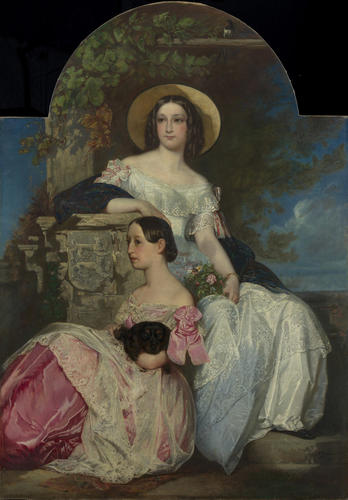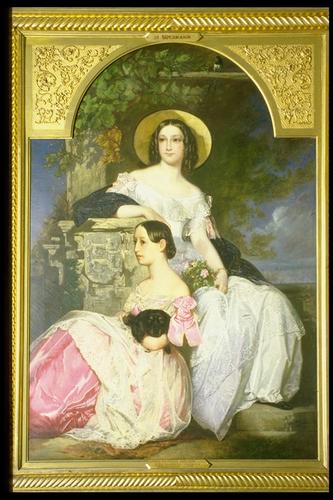Princess Adelaide of Hohenlohe-Langenburg (1835-1900) and Princess Feodore of Hohenlohe-Langenburg (1839-1872) Signed and dated 1852
Oil on canvas | 148.8 x 105.0 cm (support, canvas/panel/stretcher external) | RCIN 403886

German von Bohn (1812-1899)
Princess Adelaide of Hohenlohe-Langenburg (1835-1900) and Princess Feodore of Hohenlohe-Langenburg (1839-1872) Signed and dated 1852


-
German von Bohn (1812-1899) studied in Paris under Ary Scheffer (1795-1858) and, apart from two years in Rome, remained in Paris until 1867. From the late 1840s, he frequently worked for the French writer and racial theorist Joseph Arthur, comte de Gobineau (1816-1882), producing several portraits of Gobineau's daughters Diane and Christine (now at the Musée de l'Oise, Beauvais). In 1867, von Bohn moved to Stuttgart to work for the Würtemberg court. However, his fame then, as now, primarily rested on historical subjects, such as his Death of Cleopatra (1841, Musée des Beaux-Arts, Nantes). He was awarded medals at the 1844 and 1859 Salons and received both the Légion d'Honneur and, later, the Order of the Würtemberg Crown.
The Princesses Adelaide (1835-1900) and Feodore (1839-72) were the youngest children of Princess Feodore of Leningren and Ernst I, Prince of Hohenlohe-Langenburg (1794–1860). Feodore was Queen Victoria's half-sister, as the daughter of Victoria of Saxe-Coburg-Saalfeld, later Duchess of Kent, by her first marriage to Charles, Prince of Leiningen (1763–1814). Queen Victoria remained close to her half-sister throughout her life, and took a lively interest in her two nieces. After an initial marriage proposal from Napoléon III, which horrified the British Queen and Prince Consort, Princess Adelaide married Frederick VIII, Duke of Schleswig-Holstein in 1856 and had seven children; after her husband's death in 1880 she settled into a retired life in Dresden. Feodore married the recently widowed Georg of Saxe-Meiningen in 1858; they had three children, two of whom survived to adulthood, but Feodore died in 1872, aged 33, of scarlet fever. Her mother, the elder Feodore, died later that same year.
The two Princesses Adelaide are here depicted at full length, seated in a stone ruin engraved with the twin leopards of the Hohenlohe coat of arms. The seventeen-year old Princess Adelaide, her head framed by a sunhat, sits at the centre of the composition, with her younger sister Feodora, aged thirteen, by her side. Feodora holds a black spaniel puppy which echoes the spray of wildflowers her sister holds in her lap. A swallow is just visible in the trees above them. This painting shows the comparatively more relaxed vision of nineteenth-century royalty also visible in the paintings produced at the courts of Queen Victoria, Napoléon III and Leopold I by von Bohn's compatriot, Franz Xaver Winterhalter (1805-73). The princesses are shown outdoors, in harmony with their surroundings, and their far-off gaze implies a preoccupation with something outside the picture. However, the smoothly modelled forms also show the French-inflected neoclassical influence of von Bohn's tutor Ary Scheffer (1795-1858), and their fashionable evening dress, like the crinolines so central to Winterhalter's royal portraiture, leaves little doubt as to their high status.
Both the Duchess of Kent and Queen Victoria commissioned portraits of the princesses throughout their lives, but this painting is more likely to have been commissioned directly by the sitters' mother, the elder Princess Feodore. She had been living in Schloss Langenburg in Hohenlohe-Langenburg since her marriage in 1828, and would therefore have had opportunities to meet von Bohn, of whose work there are no other examples in the Royal Collection. This portrait was owned by Victoria, Duchess of Kent (1786-1861), mother of Queen Victoria and the present sitters' grandmother through her daughter from her first marriage, Princess Feodore of Leningren (1807-1872). It hung at the Duchess of Kent's home, Frogmore House, throughout Victoria's reign and remained the Queen's private property after her mother's death in 1861 – it passed into the Royal Collection on Victoria's own death in 1901.Provenance
Belonged to the Duchess of Kent; private property of Queen Victoria; recorded in Room no 12 at Frogmore House in 1878
-
Creator(s)
Acquirer(s)
-
Medium and techniques
Oil on canvas
Measurements
148.8 x 105.0 cm (support, canvas/panel/stretcher external)
170.2 x 125.7 x 4.5 cm (frame, external)
Category
Object type(s)
Subject(s)
Alternative title(s)
Princess Adelaide of Hohenlohe-Langenburg (1835-1900), later Princess Frederick of Augustenburg & Duchess of Schleswig-Holstein, and Princess Feodore of Hohenlohe-Langenburg (1839-1872), later Duchess of Saxe-Meiningen







